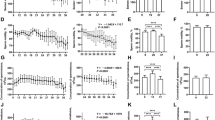Abstract
Introduction
Oxidative stress is a common pathology seen in approximately half of all infertile men. In a normal situation, the seminal plasma contains antioxidant mechanisms which are likely to quench these reactive oxygen species. However, during infertility complications these antioxidant mechanisms may downplay and create a situation which is called oxidative stress.
Objective
The aim of the present study was to assess the levels of lipid peroxide (LPO), protein peroxide (PPO) and activities of antioxidant enzymes superoxide dismutase (SOD), glutathione peroxidase (GPX) in blood and semen samples of an infertile male population from North-East India.
Method
We measured LPO, PPO, SOD and GPX in a total of 50 infertile individuals. For the study 20 fertile donors served as the control group.
Result
Patients with male factor infertility had significantly higher LPO and PPO levels (60.84 ± 3.55 and 72.84 ± 3.66; P < 0.001) compared with controls (40.20 ± 4.33 and 59.93 ± 5.24) in blood. In semen also, the same trend was found with significantly higher LPO and PPO levels (200.27 ± 6.25 and 149.80 ± 11.47; P < 0.001) compared with controls (116.51 ± 5.49 and 59.10 ± 4.62). The SOD and GPX enzymes in blood (3.40 ± 1.06 and 0.16 ± 0.01; P < 0.001) and in semen (2.42 ± 1.32 and 0.24 ± 0.015; P < 0.001) showed a significantly lower activity when compared with their respective controls (4.85 ± 0.78; 0.36 ± 0.05 and 4.24 ± 0.89; 0.65 ± 0.03). The SOD and GPX activity when compared with the LPO and PPO values, showed a positive correlation.
Conclusion
We conclude that oxidative stress is associated with male factor infertility. This assessment may help in the treatment of this male infertility by suitable antioxidants.
Similar content being viewed by others
References
Sharlip ID, Jarow JP, Belker AM, et al. Best practice policies for male infertility. Fertil Steril. 2002;77:873–82.
Aitken RJ. Molecular mechanisms regulating human sperm function. Mol Hum Reprod. 1997;3:169–73.
Agarwal A, Saleh RA, Bedaiwy MA. Role of reactive oxygen species in the pathophysiology of human reproduction. Fertil Steril. 2003;79:829–43.
Sharma RK, Agarwal A. Role of reactive oxygen species in male infertility. Urology. 1996;48:835–50.
Sikka SC. Relative impact of oxidative stress on male reproductive function. Curr Med Chem. 2001;8:851–62.
Aitken RJ. The human spermatozoon—a cell in crisis? J Reprod Fertil. 1999;115:1–7.
Saleh RA, Agarwal A, Nada AE, et al. Negative effects of increased sperm DNA damage in relation to seminal oxidative stress in men with idiopathic and male factor infertility. Fertil Steril. 2003;79:1597–605.
Sikka SC. Oxidative stress and role of antioxidants in normal and abnormal sperm function. Front Biosci. 1996;1:78–86.
Sikka SC, Rajasekaran M, Hellstrom WJ. Role of oxidative stress and antioxidants in male infertility. J Androl. 1995;16:464–81.
Aitken RJ. Free radicals, lipid peroxidation and sperm function. Reprod Fertil Dev. 1995;7:659–68.
Agarwal A, Saleh RA. Role of oxidants in male infertility: rationale, significance, and treatment. Urol Clin North Am. 2002;29:817–27.
Aitken RJ, Clarkson JS, Fishel S. Generation of reactive oxygen species, lipid peroxidation, and human sperm function. Biol Reprod. 1989;41:183–97.
World Health Organization. WHO laboratory manual for the examination of human semen and sperm-cervical mucus interaction. 4th ed. Cambridge, UK: Cambridge University Press; 1999.
Kruger TF, Acosta AA, Simmons KF, et al. New method of evaluating sperm morphology with predictive value for human in vitro fertilization. Urology. 1987;30:248–51.
Ohkawa M, Ohisi N, Yagi K. Assay for lipid peroxides in animal tissues by thiobarbituric acid reaction. Analyt Biochem. 1979;95:357–8.
Woolliams JA, Wiener G, Anderson PH. et al. Res Veter Sci. 1983;34:253–6.
Paglia DE, Valentine WN. Studies on the quantitative and qualitative characterization of erythrocyte glutathione peroxidase. J Lab Clin Med. 1967;70:158–69.
Griveau JF, Le Lannou D. Reactive oxygen species and human spermatozoa. Int J Androl. 1997;20:61–9.
Plante M, de Lamirande E, Gagnon C. Reactive oxygen species released by activated neutrophils, but not by deficient spermatozoa, are sufficient to affect normal sperm motility. Fertil Steril. 1994;62:387–93.
Alvarez JG, Touchstone JC, Blasco L, et al. Spontaneous lipid peroxidation and production of hydrogen peroxide and superoxide in human spermatozoa: superoxide dismutase as major enzyme protectant against oxygen toxicity. J Androl. 1987;8:338–48.
Li TK. The glutathione, thiol content of mammalian spermatozoa and seminal plasma. Biol Reprod. 1975;12:641–6.
Hafeman DJ, Sunde RA, Hoekstra WG. Effect of dietary selenium in erythrocyte and liver glutathione peroxidase in rates. J Nutr. 1974;104:580–7.
Lewis SEM, Boyle PM, McKinney KA, et al. Total antioxidant capacity of seminal plasma is different in fertile and infertile men. Fertil Steril. 1995;64:868–70.
Zini A, de Lamirande E, Gagnon C. Reactive oxygen species in the semen of infertile patients: levels of superoxide dismutase- and catalase-like activities in seminal plasma. Int J Androl. 1993;16:183–8.
Kobayashi J, Miyazaki T, Natori M, et al. Protective role of superoxide dismutase activity and lipid peroxide in human seminal plasma and spermatozoa. Hum Reprod. 1991;6:987–91.
Kessopoulou E, Barratt CLR, Powers HJ, et al. Rational treatment of reactive oxygen species associated male infertility with vitamin E: a double blind, randomized, placebocontrolled trial. In: 2nd International meeting of the British Fertility Society, Glasgow, U.K.; 1994. p. 7–8.
Acknowledgment
This study was supported and funded by Department of Science and Technology, Govt. of India.
Author information
Authors and Affiliations
Corresponding author
Rights and permissions
About this article
Cite this article
Mahanta, R., Gogoi, A., Chaudhury, P.N.B. et al. Association of Oxidative Stress Biomarkers and Antioxidant Enzymatic Activity in Male Infertility of North-East India. J Obstet Gynecol India 62, 546–550 (2012). https://doi.org/10.1007/s13224-011-0070-3
Received:
Accepted:
Published:
Issue Date:
DOI: https://doi.org/10.1007/s13224-011-0070-3




